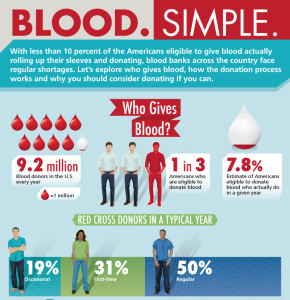With less than 10 percent of the Americans eligible to give blood actually rolling up their sleeves and donating, blood banks across the country face regular shortages. Let’s explore who gives blood, how the donation process works and why you should consider donating if you can.
Who Gives Blood?
9.2 million
Blood donors in the U.S. every year
1 in 3
Americans who are eligible to donate blood
7.8%
Estimate of Americans eligible to donate blood who actually do in a given year
Red Cross donors in a typical year
Occasional 19%
First-time 31%
Regular 50%
Understanding the Need
Every 2 seconds someone in the U.S. needs blood.
41,000
Blood donations needed every day; in a year with each donation taking about 1 pint, that would be enough to fill up 75 standard in-ground swimming pools.
A single victim from a car accident can require up to 100 pints of blood during emergency treatment.
How Blood Donation Works
Registration
Complete donor forms and provide ID.
Mini-physical
Answer a few medical questions during confidential interview; questions will cover health history and some of the places you’ve traveled.
Your temperature, hemoglobin, blood pressure and pulse will be checked.
Donation
A spot on your arm will be cleansed and a new needle inserted for the blood draw.
A whole blood donation will take about 10 minutes; other donations (such as red cells or plasma) can take up to 2 hours.
When about a pint of blood has been drawn, a staff member will place a bandage on your arm.
Recovery
Your body will need about 10-15 minutes to adjust to the decrease in fluid volume; refreshments will help you get on with your normal daily activities.
Healthy donors can give once every 56 days.
Why Give Blood?
1 donation can help save the lives of as many as 3 people
SOURCES:
http://www.bloodcenters.org
http://www.redcrossblood.org





